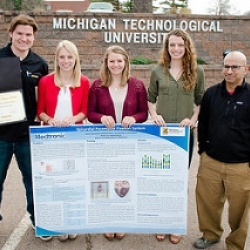
Epicardial Pacemaker Fixation
First Place 2016 Design Expo Award Winner
Team Members
Joe Nugent, Kate Boyles, Beth Sickles, and Dani Blake, Biomedical Engineering
Advisor
Rupak Rajachar, Biomedical Engineering
Sponsor
Medtronic
Project Overview
Our team will design and prototype a mechanism to fixate a one cc pacemaker to the left ventricle epicardial layer of the heart. The method must be compatible with a delivery tool that can be used to deploy, position, and attach the pacemaker through a subxiphoid incision, and the method must allow for the pacemaker to be repositioned. Key reasons for developing this technology are the greater benefit that heart failure patients may have from attaching a pacemaker to the left side of the heart and the reduced risk of thrombus due to removing the pacemaker from the bloodstream.
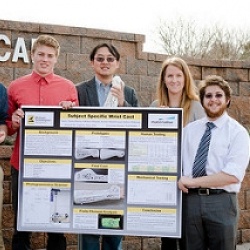
Subject-specific Orthopedic Wrist Cast
Second Place 2016 Design Expo Award Winner
Team Members
Tobias Mahan, Kathleen Moyryla, Konner Westerhouse, and Nathan Wilkinson, Biomedical Engineering
Advisor
Jingfeng Jiang, Biomedical Engineering
Sponsor
Materialise
Project Overview
Our team designed a 3D printed subject-specific orthopedic wrist cast for the immobilization of wrist fractures. We designed, built, and utilized a photogrammetric scanner to obtain the surface geometry of the subject’s arm. Two different designs were tested on human subjects to determine the feasibility of the designs.
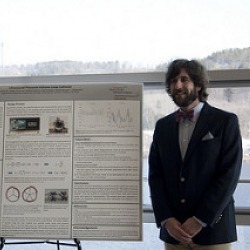
Ultrasound Pressure-Volume Loop Catheter
Team Members
Sam Richards, Brigitta Hammond, Mitchell Tahtinen, and Patrick Wolfer, Biomedical Engineering
Advisors
Michael Neuman and Smitha Rao, Biomedical Engineering
Sponsors
Helen DeVos Children’s Hospital and Spectrum Health Innovations, LLC
Project Overview
Our goal is to demonstrate a feasible method for measuring pressure and volume in near real-time without the need for calibration or excessive exposure to radiation. Location of the catheter and volume will be found using ultrasound modules in an A-scan orientation. Ultrasound modules will provide distance while pressure sensor will measure the pressure. This data will be relayed to Matlab for processing using the open-source prototyping platform Arduino. The distance data will be used to calculate the volume of the heart using an equation developed by the team. Then volume is plotted alongside pressure to obtain the Pressure-Volume loop.
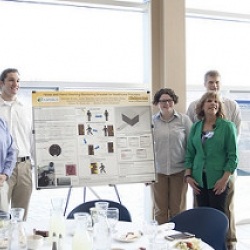
Multi-functional Bracelet to Monitor Hand Hygiene and Noise Compliance in Healthcare Environments
Team Members
Nick Brajak, Zhongtian Zhang, Jaclyn Mayrose, and Kyle Scheck, Biomedical Engineering
Advisor
Bruce Lee, Biomedical Engineering
Sponsor
Aspirus Keweenaw
Project Overview
Our objective is to develop a bracelet to be worn by healthcare staff that monitors hand hygiene compliance and noise levels in a healthcare environment. The hand hygiene component tracks compliance to hospital regulations of hand sanitation by alerting users when hand washing is needed. The bracelet also tracks and reports individual user compliance to management to show if the user is following the hand hygiene requirements of the health care facility. The noise component registers decibel levels, differing for daytime and nighttime, and alerts the user when they exceed the set limit.
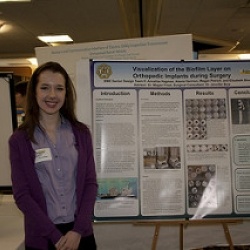
Visualization of the Biofilm Layer on Orthopedic Implants During Surgery
Team Members
Elizabeth Shumaker, Annaliza Hagman, Alanie Harmon, and Megan Petrich, Biomedical Engineering
Advisor
Megan Frost, Biomedical Engineering
Sponsors
Department of Biomedical Engineering and Dr. Jennifer Bow, Surgical Consultant
Project Overview
Our project involves the development of a method for orthopedic surgeons to visualize the biofilm layer present on the surface of infected orthopedic implants during typical hip and knee replacement revision surgeries. Biofilms are communities of bacteria embedded in a matrix of extracellular polymeric substances that present a high degree of robustness due to their three-dimensional, layered structure. This new method of visualizing these biofilms involves the use of a disclosing dye, similar to the type of disclosing dye used in children’s oral hygiene. The dye will make it easier for surgeons to effectively scrub away and remove the biofilm layer.
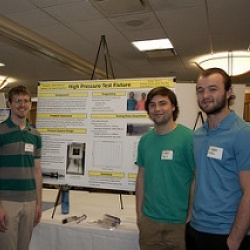
High Pressure Test Fixture Development
Team Members
Travis Redman, Matthew Tourville, Thomas Kivisto, and Thomas Koontz, Biomedical Engineering
Advisor
Sean Kirkpatrick, Biomedical Engineering
Sponsor
ACIST Medical
Project Overview
ACIST manufactures high-pressure contrast injection pumps and the high-volume disposable kits that go along with them. Our goal is to build a test fixture capable of pressure cycling at a rapid rate to simulate system use and should be customizable for different pressures and cycle settings. The pressure system will be used to test the syringe barrels in the disposable kits. This will aid in failure analysis as well as in design change verification and validation. It will also allow ACIST to resolve potential issues faster while also allowing for cost saving projects to be fully verified prior to implementation.
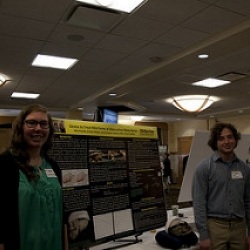
Sleep Apnea Device
Team Members
Nina Pacella, Emilee Philson, Nathan Dills, and Luke Schwerin, Biomedical Engineering
Advisor
Orhan Soykan, Biomedical Engineering
Sponsor
Michigan Technological University
Project Overview
Our team was tasked with improving sleep-assisting devices for patients with a mild form of obstructive sleep apnea. The desired device will maintain jaw protraction (forward jaw movement). This was found to increase the pharyngeal space, therefore increasing airflow to the patient. Viability is extremely important in this project because if the device does not provide enough force on the jaw to maintain protraction, it will be ineffective. There are many commercially available chinstrap devices to keep the mouth closed that could be incorporated into this device.
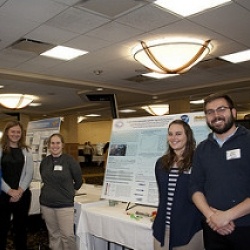
Blubber-Only Implantable Satellite Tag Anchoring System
Team Members
Megan Ahnen, Rachel Altscheffel, Caleb Vogt, and Danielle Wick, Biomedical Engineering
Advisors
Rupak Rajachar and Bruce Lee, Biomedical Engineering
Sponsors
Biomedical Engineering Department and the Office of Naval Research
Project Overview
The tracking of whale migration and movements are done through satellite telemetry tags to provide researchers information about humpback whale ecology and conservation. However, current tag designs are falling out prematurely after only 2-3 months. Furthermore, tissue swelling and muscle trauma are frequently observed at the implantation site. There is a need for a new anchoring system for attaching tracking devices to humpback whales to address these issues. Our team is developing a tag that transmits data to a satellite. These tags must stay on the whales long enough for researchers to gather the appropriate data.
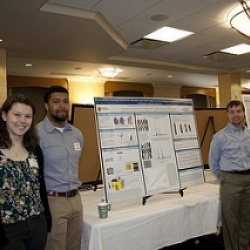
Transcatheter Single Ventricle Device for Treatment of Hypoplastic Left Heart Syndrome
Team Members
Amani Gillette, Esther Gilliland, Roger Guillory, and Patrick Malone, Biomedical Engineering
Advisors
Jeremy Goldman and Feng Zhao, Biomedical Engineering
Sponsors
Helen DeVos Children’s Hospital and Spectrum Health Innovations, LLC
Project Overview
Each year about 960 infants are born with hypoplastic left heart syndrome, a congenital heart defect that results in a severely underdeveloped heart. Four surgeries are needed to fix the defect, the first of which involves stenting of the ductus arteriosus and pulmonary artery banding. Due to the invasive nature of this first procedure at such an early developmental stage, an alternative method is desired to minimize the risk to the infant. Our team has begun development of a device that will help minimize risk while keeping the ductus arteriosus open and reducing the pressure of blood flow to the lungs.
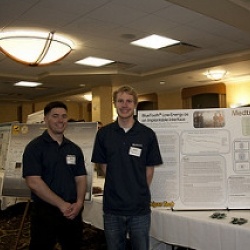
Implantable Bluetooth Low Energy (BTLE) Device
Team Members
Alex Benson, Tyler Jubenville, Nick Jones, and Joe Kristofik, Biomedical Engineering
Advisors
Orhan Soykan and Keat Ghee Ong, Biomedical Engineering
Sponsor
Medtronic
Project Overview
Bluetooth Low Energy (BTLE) is a low cost, low power specification of the Bluetooth wireless communication protocol. This makes it ideal for use in medical applications such as a patient-controlled, pain moderation device. Sponsored by Medtronic, our team seeks to evaluate the efficacy of BTLE as an implantable interface. The project goals are to evaluate factors such as bit-error rate and signal attenuation. This knowledge will aid in future research into the efficacy of BTLE as an implantable interface.